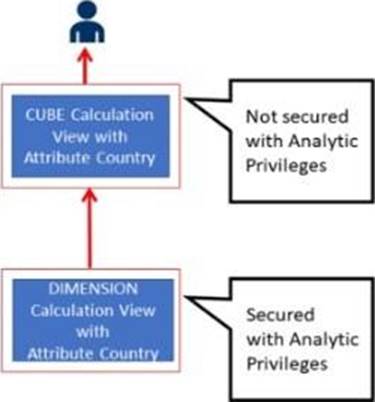SAP C_HCMOD_02 SAP Certified Application Associate – SAP HANA Cloud Modeling Online Training
SAP C_HCMOD_02 Online Training
The questions for C_HCMOD_02 were last updated at Nov 13,2025.
- Exam Code: C_HCMOD_02
- Exam Name: SAP Certified Application Associate - SAP HANA Cloud Modeling
- Certification Provider: SAP
- Latest update: Nov 13,2025
Two calculation views, A and B, are defined as shown in the diagram. Three analytic privileges have been granted to you.

When you preview calculation view A, what data do you see?
- A . US for P1 and GE for P1
- B . US for P1 and P2, and GE for P1 and P2
- C . US for P1
- D . US for P1 and P2, and GE for P2
Referring to the diagram,

which privileges would a user require to view United States data when querying the CUBE calculation view?
- A . A SELECT privilege on the CUBE calculation view and an Analytic Privilege (Country = United States) on the DIMENSION calculation view
- B . A SELECT privilege and an Analytic Privilege (Country = United States) on the DIMENSION calculation view
- C . A SELECT privilege and an Analytic Privilege (Country = United States) on the CUBE calculation view
- D . SELECT privileges and Analytic Privileges (Country = United States) on both views
You want to ensure that your calculation view does not give unexpected results for a query that is based on any combination of columns.
What is the recommended approach for verifying the results?
- A . Set the HIDE property for columns NOT required.
- B . Write and execute a custom SQL query in the SQL Console.
- C . Select Data Preview for the calculation view.
- D . Select and deselect columns from the output mapping.
A new version of SAP HANA Cloud, SAP HANA database is available from today.
If you do not perform the upgrade manually, how much time do you have before your database will be automatically upgraded to the next version?
- A . 7 months
- B . 3 months
- C . 2 weeks
- D . 1 year
Why would you enable Debug Query mode in a calculation view?
- A . To identify data sources that are not accessed by a query
- B . To check which database engines are invoked
- C . To set breakpoints and step through the execution
- D . To understand how tables are partitioned
Which tool generates and executes the SQL for a specific node of your calculation view?
- A . Debug Query mode
- B . Explain plan
- C . SQL analyzer
- D . Database explorer
Why would you create SQL in calculation views?
- A . To implement custom logic
- B . To provide an alternative to graphical modeling
- C . To fine-tune performance
- D . To enable write capabilities
What options do you have to handle orphan nodes in your hierarchy? Note: There are 2 correct answers to this question.
- A . Define an expression to determine a parent.
- B . Generate additional root nodes.
- C . Assign them to a level below the root.
- D . Assign them to a node at the root level.
Why would you use the SQL analyzer? Note: There are 2 correct answers to this question.
- A . To warn of potential performance issues related to calculated columns
- B . To display the execution time of a calculation view
- C . To identify the root data sources of a function
- D . To preview data at the node level of a calculation view
In your calculation view, you want to consume a custom data source defined using SQLScript.In which type of object do you write your code?
- A . Scalar function
- B . Table function
- C . Anonymous block
- D . Procedure
Latest C_HCMOD_02 Dumps Valid Version with 80 Q&As
Latest And Valid Q&A | Instant Download | Once Fail, Full Refund

